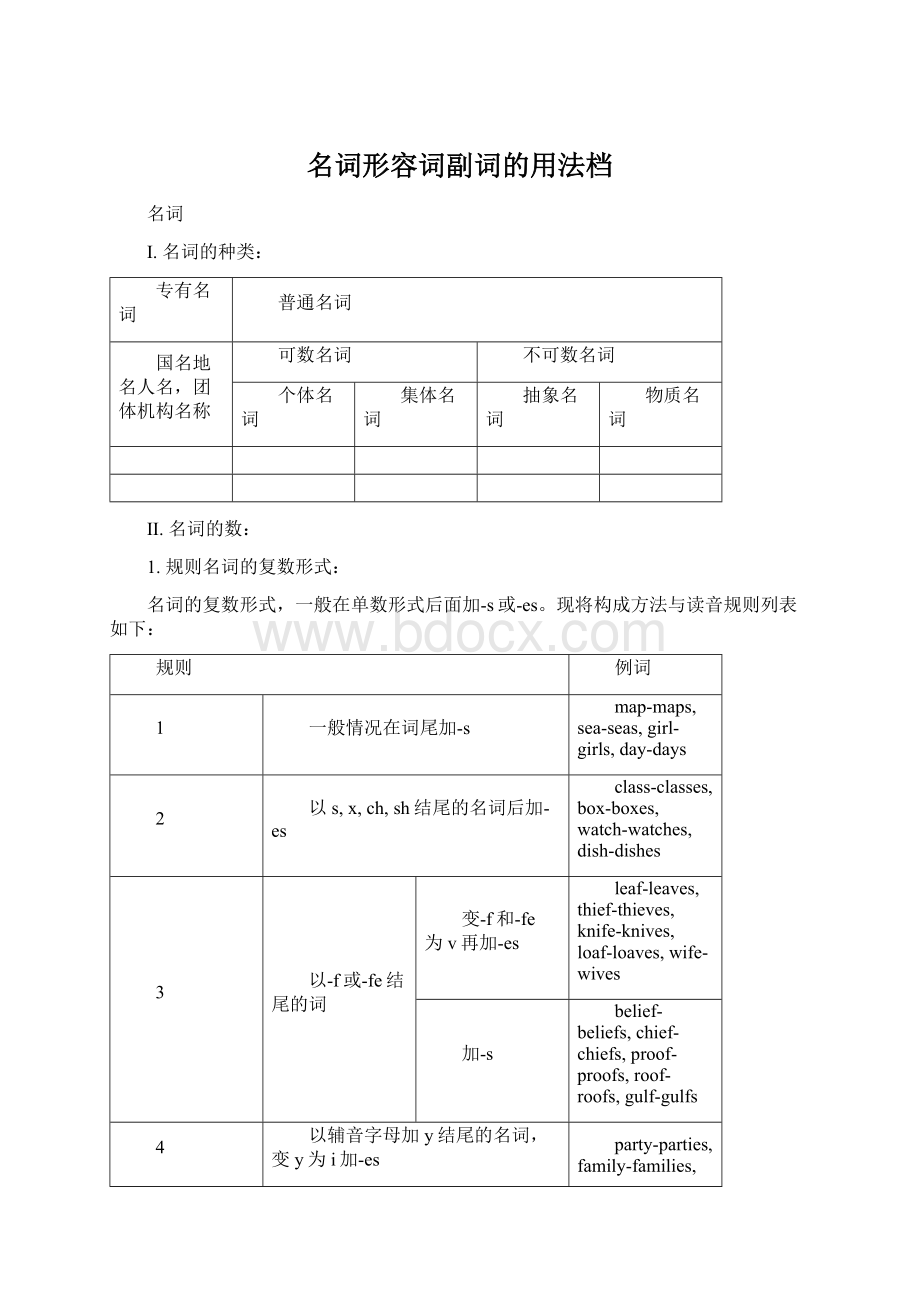名词形容词副词的用法档Word文件下载.docx
《名词形容词副词的用法档Word文件下载.docx》由会员分享,可在线阅读,更多相关《名词形容词副词的用法档Word文件下载.docx(20页珍藏版)》请在冰豆网上搜索。

不少外来词加-s
piano-pianos,photo-photos,auto-autos,kilo-kilos,solo-solos
两者皆可
zero-zeros/zeroes,volcano-volcanoes/volcanos
7
以元音字母加-o结尾的名词加-s
radio-radios,bamboo-bamboos,zoo-zoos
8
以-th结尾的名词加-s
truth-truths,mouth-mouths,month-months,path-paths,
2.不规则名词复数:
英语里有些名词的复数形式是不规则的,现归纳如下:
改变名词中的元音字母或其他形式
man-men,woman-women,foot-feet,goose-geese,mouse-mice
单复数相同
sheep,deer,series,means,works,fish,speciesli,yuan,jin,
只有复数形式
ashes,trousers,clothes,thanks,goods,glasses,compasses,contents
一些集体名词总是用作复数
people,police,cattle,staff
部分集体名词既可以作单数(整体)也可以作复数(成员)
audience,class,family,crowd,couple,group,committee,government,population,crew,team,public,enemy,party
复数形式表示特别含义
customs(海关),forces(军队),times(时代),spirits(情绪),drinks(饮料),sands(沙滩),papers(文件报纸),manners(礼貌),looks(外表),brains(头脑智力),greens(青菜),ruins(废墟)
表示“某国人”
Americans,Australians,Germans,Greeks,Swedes,Europeans
单复数同形
Swiss,Portuguese,Chinese,Japanese
以-man或-woman结尾的改为-men,-women
Englishmen,Frenchwomen
合成名词
将主体名词变为复数
sons-in-law,lookers-on,passers-by,story-tellers,boyfriends
无主体名词时将最后一部分变为复数
grown-ups,housewives,stopwatches
将两部分变为复数
womensingers,menservants
III.名词的所有格:
名词在句中表示所有关系的语法形式叫做名词所有格。
所有格分两种:
一是名词词尾加’s构成,二是由介词of加名词构成。
前者多表示有生命的东西,后者多表示无生命的东西。
1.’s所有格的构成:
单数名词在末尾加’s
theboy’sfather,Jack’sbook,herson-in-law’sphoto,
复数名词
一般在末尾加’
theteachers’room,thetwins’mother,
不规则复数名词后加’s
thechildren’stoys,women’srights,
以s结尾的人名所有格加’s或者’
Dickens’novels,Charles’sjob,theSmiths’house
表示各自的所有关系时,各名词末尾均须加’s
Japan’sandAmerica’sproblems,Jane’sandMary’sbikes
表示共有的所有关系时在最后一词末加’s
JapanandAmerica’sproblems,JaneandMary’sfather
表示"某人家""店铺",所有格后名词省略
thedoctor’s,thebarber’s,thetailor’s,myuncle’s
2.’s所有格的用法:
1
表示时间
today’snewspaper,fiveweeks’holiday
表示自然现象
theearth’satmosphere,thetree’sbranches
表示国家城市等地方的名词
thecountry’splan,theworld’spopulation,China’sindustry
表示工作群体
theship’screw,majority’sview,theteam’svictory
表示度量衡及价值
amile’sjourney,fivedollars’worthofapples
与人类活动有特殊关系的名词
thelife’stime,theplay’splot
某些固定词组
abird’seyeview,astone’sthrow,atone’swit’send(不知所措)
3.of所有格的用法:
用于无生命的东西:
thelegsofthechair,thecoverofthebook
用于有生命的东西,尤其是有较长定语时:
theclassroomsofthefirst-yearstudents
用于名词化的词:
thestruggleoftheoppressed
注:
不同国籍人的单复数
国籍总称(谓语用复数)单数复数
中国人the
Chinese,a
Chinese,two
Chinese
瑞士人the
Swiss,a
Swiss,two
Swiss
澳大利亚人the
Australians,an
Australian,two
Australians俄国人the
Russians,a
Russian,two
Russians
意大利人the
Italians,an
Italian,two
Italians
希腊人the
Greek,a
Greek,two
Greeks
法国人the
French,a
Frenchman,two
Frenchmen
日本人the
Japanese,a
Japanese,two
Japanese
美国人the
Americans,an
American,two
Americans印度人the
Indians,an
Indian,two
Indians
加拿大人the
Canadians,a
Canadian,two
Canadians德国人the
Germans,a
German,two
Germans
英国人the
English,an
Englishman,two
Englishmen瑞典人the
Swedish,a
Swede,two
Swedes
名词练习
1.The____oftheroomwerecoveredwith____.
A.roofs,leafs
B.roofs,leaves
C.rooves,leafs
D.rooves,leaves
2.Therearethree____inourfactory.
A.womandoctors
B.womendoctors
C.womandoctor
D.womendoctor
3.Whichdoyouprefer____or____?
A.potatos,tomatos
B.potatos,tomatoes
C.potatoes,tomatos
D.potatoes,tomatoes
4.Theyare____ofdifferentpresses(出版社).Nowtheyarehavingameetinginoneofthe____office.
A.editor-in-chiefs,editors-in-chief’s
B.editors-in-chief,editor-in-chief’s
C.editors-in-chiefs,editor’s-in-chief’s
D.editors-in-chief,editors-in-chief’s
5.Theanthastwo____.
A.stomaches
B.stomacks
C.stomach
D.stomachs
6.Hedoesn’tlike____forsupper.
A.chick
B.chicken
C.chickens
D.chicks
7.Itwas____hotweatherthatmanyofuswentswimming.
A.so
B.such
C.soas
D.sucha
8.____wonderfulspacetheysawontheroom!
A.How
B.HowaC.What
D.Whata
9.Weknow____travelsnotsofastaslight.
A.soundB.sounds
C.thesounds
D.asound
10.Myfamilyraisealotof____,includingtwo____.
A.cattle,cows
B.cows,cattle
C.cattles,cows
D.cow,cattles
11.Anumberofsoldiers____athecampgate(军营门口).
A.havegathered
B.hasgathered
C.is
D.was
12.TheBrownshavespentalarge____ofmoneyontheirnewcar.
A.deal
B.amount
C.number
D.size
13.____workhasbeendonetoimprovethepeople’slivingstandard.
A.Many
B.Agreatmany
C.Agreatdealof
D.Anumberof
14.MrLishook____warmlywithafriend.
A.hand
B.ahand
C.hands
D.thehands
15.Two____,please.
A.coffee
B.coffees
C.cupofcoffee
D.cupscoffee
16.Haveyoueverread____?
A.todaynewspaper
B.newspapertoday
C.newspaperoftoday
D.today’snewspaper
17.Themotheroverthereis____mother.
A.JuliaandMary
B.JuliaandMary’s
C.Julia’sandMary’s
D.Julia’sandMary
18.Therearetwo____inourclass.
A.Liu
B.Lius
C.Liu’s
D.Lius’
形容词和副词用法总结及练习
一、形容词的用法:
(一)概念:
形容词修饰名词,说明事物或人的性质或特征,通常可将形容词分成性质形容
词和叙述形容词两类,其位置不一定都放在名词前面。
1.直接说明事物的性质或特征的形容词是性质形容词。
【难点】
2.叙述形容词只能作表语,所以又称为表语形容词,这类形容词大多数以a开头的形容词都属于这一类。
例如:
afraid,asleep,awake,alone等。
(二)形容词的种类
1.品质形容词:
英语中大量形容词属于这一类,他们表示人或物的品质,如:
Theplaywasboring.那出戏很枯燥乏味。
Youhaveanhonestface.
你有一张诚实的脸。
2.颜色形容词有少数表示颜色的形容词,如:
Shehadonabluecoat.
她穿了一件蓝色的外套。
3.
-ing形容词:
有大量现在分词正在或已经变为形容词,如:
4.–ed形容词:
它们是由它们的过去分词变过来的,一般有被动意义,多数为品质形容词,如:
Shelookedtired.
5.合成形容词:
warm-hearted热心的,heart-breaking
令人心碎的
(三)形容词的用法和在句中的位置
1、形容词在句中主要可用作:
1)定语:
Whatafineday!
2)表语:
Shelookshappy.
3)宾语的补语(构成合成宾语):
Doyouthinkitnecessary?
你认为这有必要吗?
4)状语:
Hearrivedhome,hungryandtired.
他又饿又累的回到家里。
2、形容词在句中的位置:
有的形容词放在被修饰的名词之前,称为前置形容词;
少数形容词放在被修饰的名词之后,称为后置形容词。
1)当名词被多个前置形容词修饰时,形容词之间有一个先后顺序问题。
一般规则为:
(限定词)→一般描绘性形容词→表示大小、长短、高低的形容词→表示年龄、新旧的形容词→表示国籍、地区、出处的形容词→表示物质、材料的形容词→(名词)。
如:
Thereisafamousfineoldstonebridgenearthevillage.
村子附近有一座著名的漂亮的古代石桥。
【重点】
2)当形容词词组相当于一个定语从句时,或形容词用来修饰somebody,something,anything,nothing等的时候,便会出现后置形容词。
Theboyinterestedinmusicismybrother.对音乐赶兴趣的那个男孩是我弟弟。
Doyouhaveanythinginterestingtotellus?
你有什么趣闻告诉我们吗?
二、副词的用法:
用以修饰动词、形容词或其他副词的词叫做副词。
not(不),here(这里),now(现在)。
不少副词同时也可用作介词或其它词类。
Haveyoureadthisbookbefore?
(副词,作时间状语)你以前读过这本书吗?
Hewillarrivebeforeteno’clock.(介词,beforeteno’clock是介词短语,作时间状语)他将在10点钟前到达。
(二)副词的种类
1、时间副词有三类:
always,often,usually,sometimes,never,ever,hardly等一般位于系动词、情态动词和助动词之后,实之前义动词
1)表示发生时间的副词:
It’sbeginningtorainnow!
现在开始下雨了!
2)表示频繁程度的副词,也称频度副词always,often,usually,sometimes,never,ever,hardly等一般位于系动词、情态动词和助动词之后,实之前义动词:
Sheoftenchangeshermind.
她常改变主意。
3)还有一些其他表示时间的副词:
Hehasjusthadanoperation.他刚动过手术。
2、地点副词:
1)有不少表示地点的副词:
Sheisstudyingabroad.
她在国外留学。
2)还有一些部分与介词同形的副词。
它们与介词同形,跟宾语的是介词,否则是副词:
①用作介词:
Standup!
起立!
②用作副词:
Acatclimbedupthetree.
猫爬上了树。
3)以where构成的副词也是地点副词:
It’sthesameeverywhere.
到处都一样。
3、方式副词
1)英语中有大量方式副词,说明行为方式(回答how的问题):
Howbeautifullyyourwifedances.
你夫人舞跳的真美。
2)还有相当多的副词,表示某些情绪:
Shesmiledgratefully.
她感激的笑了笑。
3)还有一些以-ly结尾的副词,表示动作发生的状况:
Heleftthetownsecretly.他悄然离开了这座城市。
4、程度副词和强调副词
1)程度副词可修饰动词,表示“到某种程度”:
Isshebadlyhurt?
她伤得重吗?
[说明]这类副词除修饰动词外,还可修饰形容词(a)或另一副词(b):
a.fairlysimple相当简单quitecorrect完全正确
b.wonderfullywell好极了doitveryquickly干得很快
2)much是一个特殊的程度副词,它可以:
a.修饰形容词等:
I’mnotmuchgoodatsinging.我唱歌不太好。
b.修饰比较级:
Yousingmuchbetterthanme.你比我唱的好多了。
Theirhouseismuchnicerthanours.他们的房子比我们的好多了。
5.疑问副词和连接副词
1)疑问副词:
疑问副词用来引导特殊问句:
how:
Howisyourgrandmother?
你奶奶身体好吗?
where:
Wheredoesshecomefrom?
她是哪儿人?
when:
Whencanyoucome?
你什么时候能来?
why:
Whywashesolate?
他为什么来得这么晚?
2)连接副词:
连接副词意思和词形都和疑问副词一样,但都引导从句或与不定式连用:
how:
Doyouknowhowtostartthismachine?
你知道这台机器怎样启动吗?
where:
Idon’tknowwherehelives.我不知道他住在哪儿。
(引导宾语从句)
when:
Tellmewhenyou’llbeready.告诉我你什么时候准备好。
why:
That’swhyIcameround.这就是我来的原因。
(引导表语从句)
6.一些其它类型的副词,如表示方向的副词:
Let’sgoinside.咱们到里面去。
Taketwostepsforward.向前走两步。
(三)副词的位置
1.副词修饰动词时,通常可以放在句首、句中或句末。
UsuallyIdomyhomeworkintheevening.(句首)通常我晚上做家庭作业。
Ioftengetupatsix.(句中)我常在6点起床。
Pleasespeakslowly.(句末)请慢慢说。
2.副词修饰形容词或副词时,通常放在形容词或副词的前面如:
Theseflowersarequitebeautiful.(在形容词前)这些花相当漂亮。
Heworksveryhard.(在副词前)他工作很努力。
▲但也有例外,如:
Sheisoldenoughtogotoschool.(在形容词后)她已到了上学的年龄。
3.按一般规则,既有地点状语又有时间状语时,地点状语应放在时间状语